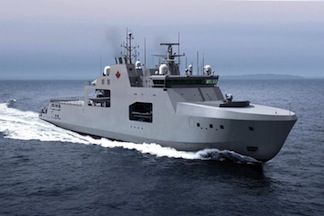The following is the text of a news release from the government of Canada:
(HALIFAX, Nova Scotia) — The government of Canada has announced the start of construction on the third Arctic offshore patrol ship (AOPS), the future HMCS Max Bernays, in Nova Scotia. The government is committed to rebuilding the marine industry, supporting Canadian technological innovation, and bringing good middle-class jobs to communities across Canada through the National Shipbuilding Strategy.
The National Shipbuilding Strategy offers significant opportunities to Canadians and Canadian suppliers, with contracts being issued by both the government and by shipyards to hundreds of firms across Canada, including a significant number to small and medium-sized enterprises.
The announcement represents an important milestone for Irving Shipbuilding Inc., the government of Canada, and the National Shipbuilding Strategy, which will deliver both large and small ships, as well as ship repair, refit and maintenance.
"Today's announcement speaks to the value of collaboration with the Royal Canadian Navy, and other partners at the federal, provincial, municipal and community level. Working together, we are turning the goals of the strategy into reality while ensuring the women and men of the Canadian Armed Forces get the equipment they need to do their jobs," said Carla Qualtrough, minister of public services and procurement.
Quick facts
• In September 2015, steel was cut on the first AOPS, the future HMCS Harry DeWolf. On Dec. 8, 2017, megablock 3 of this first AOPS was moved outside the Ultra Hall to the land level exterior production area and was joined to the first two megablocks to make up the entire vessel.
• The second AOPS, the future HMCS Margaret Brooke, began construction in August 2016. This second vessel is progressing as scheduled at the Halifax Shipyard.
• On Dec. 19, Irving Shipbuilding cut steel on the third of the combat vessels designed and built under the National Shipbuilding Strategy. These vessels will provide armed, sea-borne surveillance of Canadian waters, including in the Arctic where they will enforce Canadian sovereignty in cooperation with Canadian Armed Forces (CAF) partners and other government departments and provide important awareness of activities in Canada's waters.
• As a result of its work under the National Shipbuilding Strategy, Halifax Shipyard and its major subcontractors have over $1.9 billion in spending commitments with more than 250 Canadian organizations.
• It is estimated that NSS contracts awarded to date will contribute roughly $7.7 billion to Canada's GDP, and roughly 7,350 jobs per year, on average, will be created or maintained between 2012 and 2022.

